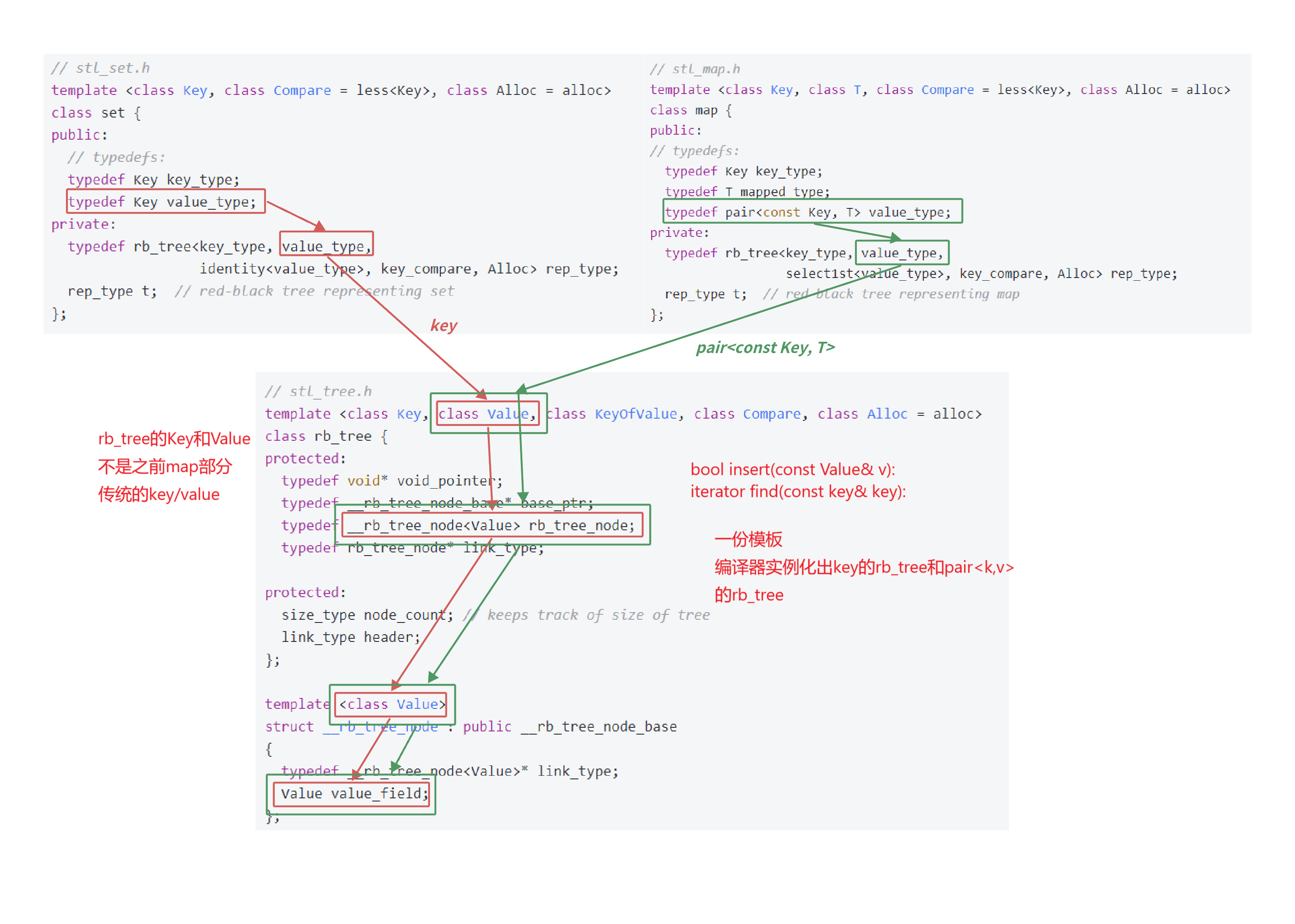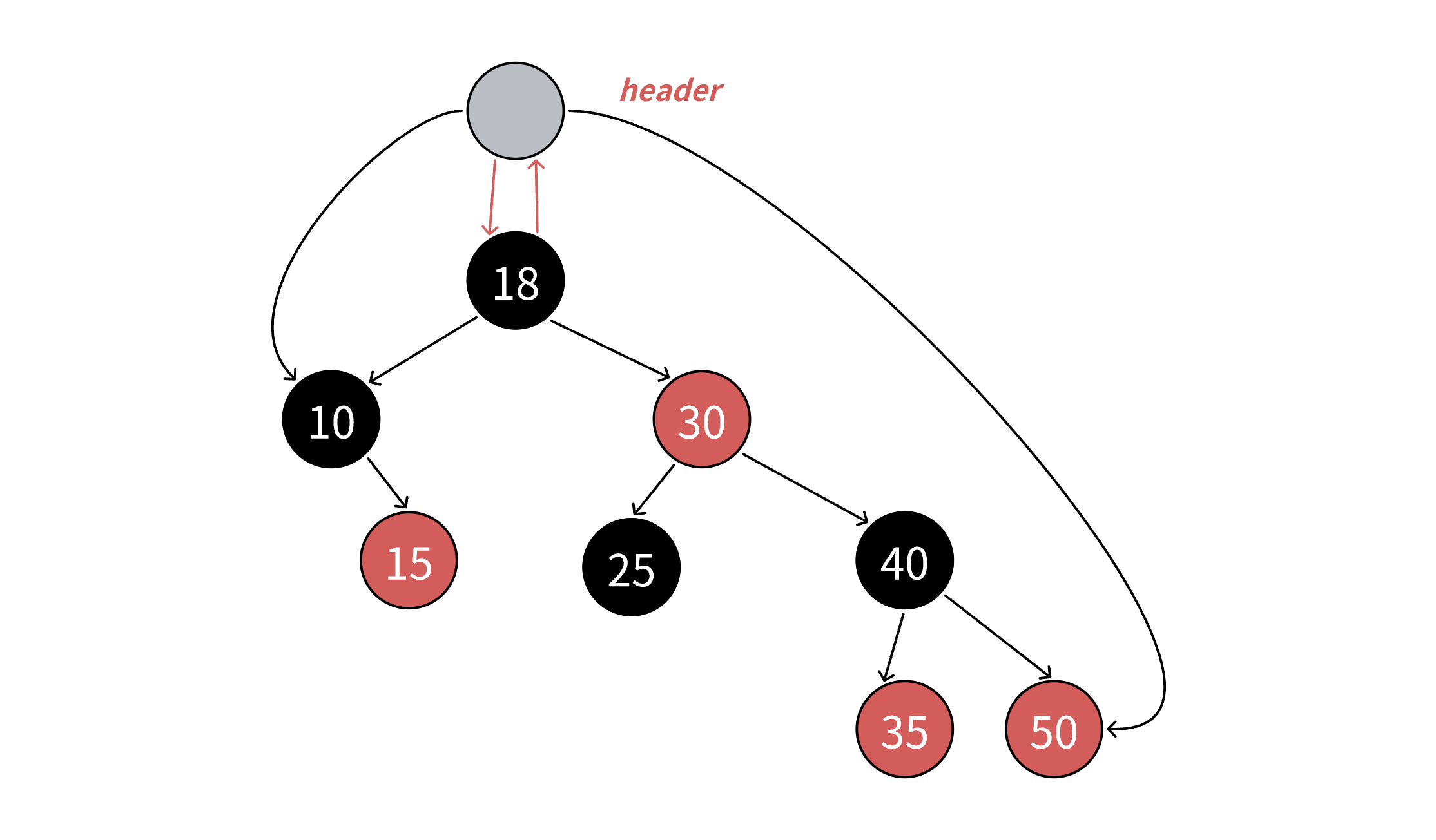封装红⿊树实现mymap和myset
本文分析了SGI-STL30版本中map和set的实现原理,并基于红黑树(RBTree)进行了模拟实现。主要内容包括: 源码分析:map和set底层通过红黑树实现,采用泛型设计,通过模板参数控制数据结构。map存储pair<const K,V>,set存储K,通过KeyOfT仿函数提取键值进行比较。 框架实现:设计RBTree模板类,支持map和set的复用。关键点包括: 节点结构RB
·
1.源码分析
SGI-STL30版本源代码,map和set的源代码在map/set/stl_map.h/stl_set.h/stl_tree.h等⼏个头⽂件 中。 map和set的实现结构框架核⼼部分截取出来如下:
// set
#ifndef __SGI_STL_INTERNAL_TREE_H
#include <stl_tree.h>
#endif
#include <stl_set.h>
#include <stl_multiset.h>
// map
#ifndef __SGI_STL_INTERNAL_TREE_H
#include <stl_tree.h>
#endif
#include <stl_map.h>
#include <stl_multimap.h>
// stl_set.h
template <class Key, class Compare = less<Key>, class Alloc = alloc>
class set {
public:
// typedefs:
typedef Key key_type;
typedef Key value_type;
private:
typedef rb_tree<key_type, value_type,
identity<value_type>, key_compare, Alloc> rep_type;
rep_type t; // red-black tree representing set
};
// stl_map.h
template <class Key, class T, class Compare = less<Key>, class Alloc = alloc>
class map {
public:
// typedefs:
typedef Key key_type;
typedef T mapped_type;
typedef pair<const Key, T> value_type;
private:
typedef rb_tree<key_type, value_type,
select1st<value_type>, key_compare, Alloc> rep_type;
rep_type t; // red-black tree representing map
};
// stl_tree.h
struct __rb_tree_node_base
{
typedef __rb_tree_color_type color_type;
typedef __rb_tree_node_base* base_ptr;
color_type color;
base_ptr parent;
base_ptr left;
base_ptr right;
};
// stl_tree.h
template <class Key, class Value, class KeyOfValue, class Compare, class Alloc
= alloc>
class rb_tree {
protected:
typedef void* void_pointer;
typedef __rb_tree_node_base* base_ptr;
typedef __rb_tree_node<Value> rb_tree_node;
typedef rb_tree_node* link_type;
typedef Key key_type;
typedef Value value_type;
public:
// insert⽤的是第⼆个模板参数做形参
pair<iterator, bool> insert_unique(const value_type& x);
// erase和find⽤第⼀个模板参数做形参
size_type erase(const key_type& x);
iterator find(const key_type& x);
protected:
size_type node_count; // keeps track of size of tree
link_type header;
};
template <class Value>
struct __rb_tree_node : public __rb_tree_node_base
{
typedef __rb_tree_node<Value>* link_type;
Value value_field;
};
• 通过下图对框架的分析,我们可以看到源码中rb_tree⽤了⼀个巧妙的泛型思想实现,rb_tree是实
现key的搜索场景,还是key/value的搜索场景不是直接写死的,⽽是由第⼆个模板参数Value决定
_rb_tree_node中存储的数据类型。
• set实例化rb_tree时第⼆个模板参数给的是key,map实例化rb_tree时第⼆个模板参数给的是
pair<const key, T>,这样⼀颗红⿊树既可以实现key搜索场景的set,也可以实现key/value搜索场
景的map。
• 要注意⼀下,源码⾥⾯模板参数是⽤T代表value,⽽内部写的value_type不是我们我们⽇常
key/value场景中说的value,源码中的value_type反⽽是红⿊树结点中存储的真实的数据的类型。
• rb_tree第⼆个模板参数Value已经控制了红⿊树结点中存储的数据类型,为什么还要传第⼀个模板参数Key呢?尤其是set,两个模板参数是⼀样的。要注意的是对于map和set,find/erase时的函数参数都是Key,所以第⼀个模板参数是传给find/erase等函数做形参的类型的。对于set⽽⾔两个参数是⼀样的,但是对于map⽽⾔就完全不⼀样了,map insert的是pair对象,但是find和ease的是Key对象。
• 这⾥源码命名⻛格⽐较乱,set模板参数⽤的Key命名,map⽤的是Key和T命名,⽽rb_tree⽤的⼜是Key和Value。

2. 模拟实现map和set
2.1 实现出复⽤红⿊树的框架,并⽀持insert
• 参考源码框架,map和set复⽤之前我们实现的红⿊树。
•我们这⾥相⽐源码调整⼀下,key参数就⽤K,value参数就⽤V,红⿊树中的数据类型,我们使⽤
T。
• 其次因为RBTree实现了泛型不知道T参数导致是K,还是pair<K, V>,那么insert内部进⾏插⼊逻辑⽐较时,就没办法进⾏⽐较,因为pair的默认⽀持的是key和value⼀起参与⽐较,我们需要时的任何时候只⽐较key,所以我们在map和set层分别实现⼀个MapKeyOfT和SetKeyOfT的仿函数传给RBTree的KeyOfT,然后RBTree中通过KeyOfT仿函数取出T类型对象中的key,再进⾏⽐较。
// 源码中pair⽀持的<重载实现
template <class T1, class T2>
bool operator< (const pair<T1, T2>& lhs, const pair<T1, T2>& rhs)
{
return lhs.first < rhs.first || (!(rhs.first < lhs.first) &&
lhs.second < rhs.second);
}
// Mymap.h
namespace sy
{
template<class K, class V>
class map
{
struct MapKeyOfT
{
const K& operator()(const pair<K, V>& kv)
{
return kv.first;
}
};
public:
bool insert(const pair<K, V>& kv)
{
return _t.Insert(kv);
}
private:
RBTree<K, pair<K, V>, MapKeyOfT> _t;
};
}
// Myset.h
namespace sy
{
template<class K>
class set
{
struct SetKeyOfT
{
const K& operator()(const K& key)
{
return key;
}
};
public:
bool insert(const K& key)
{
return _t.Insert(key);
}
private:
RBTree<K, K, SetKeyOfT> _t;
};
}
// RBTree.h
enum Colour
{
RED,
BLACK
};
template<class T>
struct RBTreeNode
{
T _data;
RBTreeNode<T>* _left;
RBTreeNode<T>* _right;
RBTreeNode<T>* _parent;
Colour _col;
RBTreeNode(const T& data)
: _data(data)
, _left(nullptr)
, _right(nullptr)
, _parent(nullptr)
{}
};
// 实现步骤:
// 1、实现红⿊树
// 2、封装map和set框架,解决KeyOfT
// 3、iterator
// 4、const_iterator
// 5、key不⽀持修改的问题
// 6、operator[]
template<class K, class T, class KeyOfT>
class RBTree
{
private:
typedef RBTreeNode<T> Node;
Node* _root = nullptr;
public:
bool Insert(const T& data)
{
if (_root == nullptr)
{
_root = new Node(data);
_root->_col = BLACK;
return true;
}
KeyOfT kot;
Node* parent = nullptr;
Node* cur = _root;
while (cur)
{
if (kot(cur->_data) < kot(data))
{
parent = cur;
cur = cur->_right;
}
else if (kot(cur->_data) > kot(data))
{
parent = cur;
cur = cur->_left;
}
else
{
return false;
}
}
cur = new Node(data);
Node* newnode = cur;
// 新增结点。颜⾊给红⾊
cur->_col = RED;
if (kot(parent->_data) < kot(data))
{
parent->_right = cur;
}
else
{
parent->_left = cur;
}
cur->_parent = parent;
//...
return true;
}
};2.2 ⽀持iterator的实现
iterator核⼼源代码
struct __rb_tree_base_iterator
{
typedef __rb_tree_node_base::base_ptr base_ptr;
base_ptr node;
void increment()
{
if (node->right != 0) {
node = node->right;
while (node->left != 0)
node = node->left;
}
else {
base_ptr y = node->parent;
while (node == y->right) {
node = y;
y = y->parent;
}
if (node->right != y)
node = y;
}
}
void decrement()
{
if (node->color == __rb_tree_red &&
node->parent->parent == node)
node = node->right;
else if (node->left != 0) {
base_ptr y = node->left;
while (y->right != 0)
y = y->right;
node = y;
}
else {
base_ptr y = node->parent;
while (node == y->left) {
node = y;
y = y->parent;
}
node = y;
}
}
};
template <class Value, class Ref, class Ptr>
struct __rb_tree_iterator : public __rb_tree_base_iterator
{
typedef Value value_type;
typedef Ref reference;
typedef Ptr pointer;
typedef __rb_tree_iterator<Value, Value&, Value*> iterator;
__rb_tree_iterator() {}
__rb_tree_iterator(link_type x) { node = x; }
__rb_tree_iterator(const iterator& it) { node = it.node; }
reference operator*() const { return link_type(node)->value_field; }
#ifndef __SGI_STL_NO_ARROW_OPERATOR
pointer operator->() const { return &(operator*()); }
#endif /* __SGI_STL_NO_ARROW_OPERATOR */
self& operator++() { increment(); return *this; }
self& operator--() { decrement(); return *this; }
inline bool operator==(const __rb_tree_base_iterator& x,
const __rb_tree_base_iterator& y) {
return x.node == y.node;
}
inline bool operator!=(const __rb_tree_base_iterator& x,
const __rb_tree_base_iterator& y) {
return x.node != y.node;
}iterator实现思路分析
• iterator实现的⼤框架跟list的iterator思路是⼀致的,⽤⼀个类型封装结点的指针,再通过重载运算
符实现,迭代器像指针⼀样访问的⾏为。
• 这⾥的难点是operator++和operator--的实现。之前使⽤部分,我们分析了,map和set的迭代器⾛ 的是中序遍历,左⼦树->根结点->右⼦树,那么begin()会返回中序第⼀个结点的iterator也就是10所在结点的迭代器。
• 迭代器++的核⼼逻辑就是不看全局,只看局部,只考虑当前中序局部要访问的下⼀个结点。
• 迭代器++时,如果it指向的结点的右⼦树不为空,代表当前结点已经访问完了,要访问下⼀个结点是右⼦树的中序第⼀个,⼀棵树中序第⼀个是最左结点,所以直接找右⼦树的最左结点即可。
• 迭代器++时,如果it指向的结点的右⼦树空,代表当前结点已经访问完了且当前结点所在的⼦树也访问完了,要访问的下⼀个结点在当前结点的祖先⾥⾯,所以要沿着当前结点到根的祖先路径向上找。
• 如果当前结点是⽗亲的左,根据中序左⼦树->根结点->右⼦树,那么下⼀个访问的结点就是当前结点的⽗亲;如下图:it指向25,25右为空,25是30的左,所以下⼀个访问的结点就是30。
• 如果当前结点是⽗亲的右,根据中序左⼦树->根结点->右⼦树,当前当前结点所在的⼦树访问完
了,当前结点所在⽗亲的⼦树也访问完了,那么下⼀个访问的需要继续往根的祖先中去找,直到找
到孩⼦是⽗亲左的那个祖先就是中序要访问的下⼀个结点。如下图:it指向15,15右为空,15是10
的右,15所在⼦树话访问完了,10所在⼦树也访问完了,继续往上找,10是18的左,那么下⼀个
访问的结点就是18。
• end()如何表⽰呢?如下图:当it指向50时,++it时,50是40的右,40是30的右,30是18的右,18
到根没有⽗亲,没有找到孩⼦是⽗亲左的那个祖先,这是⽗亲为空了,那我们就把it中的结点指针
置为nullptr,我们⽤nullptr去充当end。需要注意的是stl源码中,红⿊树增加了⼀个哨兵位头结点
做为end(),这哨兵位头结点和根互为⽗亲,左指向最左结点,右指向最右结点。相⽐我们⽤
nullptr作为end(),差别不⼤,他能实现的,我们也能实现。只是--end()判断到结点时空,特殊处
理⼀下,让迭代器结点指向最右结点。具体参考迭代器--实现。
• 迭代器--的实现跟++的思路完全类似,逻辑正好反过来即可,因为他访问顺序是右⼦树->根结点->左⼦树,具体参考代码实现。
• set的iterator也不⽀持修改,我们把set的第⼆个模板参数改成const K即可, RBTree<K,
const K, SetKeyOfT> _t;
• map的iterator不⽀持修改key但是可以修改value,我们把map的第⼆个模板参数pair的第⼀个参
数改成const K即可, RBTree<K, pair<const K, V>, MapKeyOfT> _t;
• ⽀持完整的迭代器还有很多细节需要修改,具体参考下⾯的代码。


3.RBTree.h
#pragma once
enum colour
{
RED,
BLACK
};
template<class T>
struct RBTreeNode
{
T _data;
RBTreeNode<T>* _left;
RBTreeNode<T>* _right;
RBTreeNode<T>* _parent;
colour _col;
RBTreeNode(const T& data)
: _left(nullptr)
, _right(nullptr)
, _parent(nullptr)
, _data(data)
{}
};
template <class T, class Ref, class Ptr>
struct RBTreeIterator
{
typedef RBTreeNode<T> Node;
typedef RBTreeIterator<T, Ref, Ptr> Self;
Node* _node;
Node* _root;
RBTreeIterator(Node* node,Node* root)
:_node(node)
,_root(root)
{}
Self operator++()
{
//如果it指向的结点的右⼦树不为空,代表当前结点已经访问完了
//要访问下⼀个结点是右⼦树的中序第⼀个
//⼀棵树中序第⼀个是最左结点,所以直接找右⼦树的最左结点
if (_node->_right)
{
Node* leftmax = _node->_right;
while (leftmax->_left)
{
leftmax = leftmax->_left;
}
_node = leftmax;
}
// 右为空,找到祖先里面孩子是父亲左的那个祖先
else
{
Node* cur = _node;
Node* parent = cur->_parent;
while (parent && cur == parent->_right)
{
cur = parent;
parent = cur->_parent;
}
_node = parent;
}
return *this;
}
//右⼦树->根结点->左⼦树
Self operator--()
{
// --end()
if (_node == nullptr)
{
//--end(),特殊处理,走到整棵树的最右节点
Node* rightmost = _root;
while (rightmost && rightmost->_right)
{
rightmost = rightmost->_right;
}
_node = rightmost;
}
else if (_node->_left)
{
//左不为空,找左子树的最右节点
Node* rightmax = _node->_left;
while (rightmax->_right)
{
rightmax = rightmax->_right;
}
_node = rightmax;
}
else
{
//左为空,找到祖先里面孩子是父亲右的那个祖先
Node* cur = _node;
Node* parent = cur->_parent;
while (parent && cur == parent->_left)
{
cur = parent;
parent = parent->_parent;
}
_node = parent;
}
return *this;
}
Ref operator*()
{
return _node->_data;
}
Ptr operator->()
{
return &_node->_data;
}
bool operator!=(const Self& s) const
{
return _node != s._node;
}
bool operator==(const Self& s) const
{
return _node == s._node;
}
};
template<class K, class T,class KeyOfT>
class RBTree
{
typedef RBTreeNode<T> Node;
public:
typedef RBTreeIterator<T, T&, T*> Iterator;
typedef RBTreeIterator<T, const T&, const T*> ConstIterator;
Iterator Begin()
{
//最左节点
Node* cur = _root;
while (cur && cur->_left)
{
cur = cur->_left;
}
return Iterator(cur, _root);
}
Iterator End()
{
return Iterator(nullptr, _root);
}
ConstIterator Begin() const
{
//最左节点
Node* cur = _root;
while (cur && cur->_left)
{
cur = cur->_left;
}
return ConstIterator(cur, _root);
}
ConstIterator End() const
{
return ConstIterator(nullptr, _root);
}
pair<Iterator, bool> Insert(const T& data)
{
if (_root == nullptr)
{
_root = new Node(data);
_root->_col = BLACK;
return { Iterator(_root,_root),true };
}
KeyOfT kot;
Node* parent = nullptr;
Node* cur = _root;
while (cur)
{
if (kot(data) > kot(cur->_data))
{
parent = cur;
cur = cur->_right;
}
else if (kot(data) < kot(cur->_data))
{
parent = cur;
cur = cur->_left;
}
else
{
return {Iterator(cur,_root),true};
}
}
cur = new Node(data);
Node* newnode = cur;
cur->_col = RED;
if (kot(data) > kot(parent->_data))
{
parent->_right = cur;
}
else
{
parent->_left = cur;
}
//链接父亲
cur->_parent = parent;
// 父亲是红色,出现连续的红色节点,需要处理
while (parent && parent->_col == RED)
{
Node* grandfather = parent->_parent;
if (parent == grandfather->_left)
{
// g
// p u
// 情况 1:uncle存在且为红 只需要变色 继续往上更新即可
Node* uncle = grandfather->_right;
if (uncle && uncle->_col == RED)
{
parent->_col = BLACK;
uncle->_col = BLACK;
grandfather->_col = RED;
// 继续往上处理
cur = grandfather;
parent = cur->_parent;
}
// 情况 2:叔叔不存在,或者存在且为黑
else
{
// g
// p u
//c
if (cur == parent->_left)
{
RotateR(grandfather);
parent->_col = BLACK;
grandfather->_col = RED;
}
// g
// p u
// c
else
{
RotateL(parent);
RotateR(grandfather);
cur->_col = BLACK;
grandfather->_col = RED;
}
break;
}
}
//parent == grandfather->_right
else
{ // g
// u p
Node* uncle = grandfather->_left;
if (uncle && uncle->_col == RED)
{
parent->_col = BLACK;
uncle->_col = BLACK;
grandfather->_col = RED;
// 继续往上处理
cur = grandfather;
parent = cur->_parent;
}
else
{ // g
// u p
// c
if (cur == parent->_right)
{
RotateL(grandfather);
parent->_col = BLACK;
grandfather->_col = RED;
}
// g
// u p
// c
else
{
RotateR(parent);
RotateL(grandfather);
cur->_col = BLACK;
grandfather->_col = RED;
}
break;
}
}
}
_root->_col = BLACK;
return {Iterator(newnode,_root),true};
}
void RotateR(Node* parent)
{
Node* subL = parent->_left;
Node* subLR = subL->_right;
parent->_left = subLR;
if (subLR)
subLR->_parent = parent;
Node* pParent = parent->_parent;
subL->_right = parent;
parent->_parent = subL;
if (parent == _root)
{
_root = subL;
subL->_parent = nullptr;
}
else
{
if (pParent->_left == parent)
{
pParent->_left = subL;
}
else
{
pParent->_right = subL;
}
subL->_parent = pParent;
}
}
void RotateL(Node* parent)
{
Node* subR = parent->_right;
Node* subRL = subR->_left;
parent->_right = subRL;
if (subRL)
subRL->_parent = parent;
Node* parentParent = parent->_parent;
subR->_left = parent;
parent->_parent = subR;
if (parentParent == nullptr)
{
_root = subR;
subR->_parent = nullptr;
}
else
{
if (parent == parentParent->_left)
{
parentParent->_left = subR;
}
else
{
parentParent->_right = subR;
}
subR->_parent = parentParent;
}
}
void InOrder()
{
_InOrder(_root);
cout << endl;
}
int Height()
{
return _Height(_root);
}
int Size()
{
return _Size(_root);
}
Node* Find(const K& data)
{
Node* cur = _root;
KeyOfT kot;
while (cur)
{
if (kot(cur->_data) < kot(data))
{
cur = cur->_right;
}
else if (kot(cur->_data) > kot(data))
{
cur = cur->_left;
}
else
{
return cur;
}
}
return nullptr;
}
bool IsBalance()
{
if (_root == nullptr)
return true;
if (_root->_col == RED)
return false;
// 参考值
int refNum = 0;
Node* cur = _root;
while (cur)
{
if (cur->_col == BLACK)
{
++refNum;
}
cur = cur->_left;
}
return Check(_root, 0, refNum);
}
private:
bool Check(Node* root, int blackNum, const int refNum)
{
if (root == nullptr)
{
// 前序遍历走到空时,意味着一条路径走完了
//cout << blackNum << endl;
if (refNum != blackNum)
{
cout << "存在黑色结点的数量不相等的路径" << endl;
return false;
}
return true;
}
// 检查孩子不太方便,因为孩子有两个,且不一定存在,反过来检查父亲就方便多了
if (root->_col == RED && root->_parent->_col == RED)
{
cout << root->_kv.first << "存在连续的红色结点" << endl;
return false;
}
if (root->_col == BLACK)
{
blackNum++;
}
return Check(root->_left, blackNum, refNum)
&& Check(root->_right, blackNum, refNum);
}
void _InOrder(Node* root)
{
if (root == nullptr)
{
return;
}
_InOrder(root->_left);
cout << root->_kv.first << ":" << root->_kv.second << endl;
_InOrder(root->_right);
}
int _Height(Node* root)
{
if (root == nullptr)
return 0;
int leftHeight = _Height(root->_left);
int rightHeight = _Height(root->_right);
return leftHeight > rightHeight ? leftHeight + 1 : rightHeight + 1;
}
int _Size(Node* root)
{
if (root == nullptr)
return 0;
return _Size(root->_left) + _Size(root->_right) + 1;
}
private:
Node* _root = nullptr;
};
4.myset.h
#pragma once
#include "RBTree.h"
namespace sy
{
template<class K>
class set
{
struct SetKeyOfT
{
const K& operator()(const K& key)
{
return key;
}
};
public:
typedef typename RBTree<K, const K, SetKeyOfT>::Iterator iterator;
typedef typename RBTree<K, const K, SetKeyOfT>::ConstIterator const_iterator;
iterator begin()
{
return _t.Begin();
}
iterator end()
{
return _t.End();
}
const_iterator begin() const
{
return _t.Begin();
}
const_iterator end() const
{
return _t.End();
}
pair<iterator, bool> insert(const K& key)
{
return _t.Insert(key);
}
private:
RBTree<K, const K, SetKeyOfT> _t;
};
}
5.mymap.h
#pragma once
#include "RBTree.h"
namespace sy
{
template<class K,class V>
class map
{
struct MapKeyOfT
{
const K& operator()(const pair<K,V>& kv)
{
return kv.first;
}
};
public:
typedef typename RBTree<K, pair<const K,V>, MapKeyOfT>::Iterator iterator;
typedef typename RBTree<K, pair<const K,V>, MapKeyOfT>::ConstIterator const_iterator;
iterator begin()
{
return _t.Begin();
}
iterator end()
{
return _t.End();
}
const_iterator begin() const
{
return _t.Begin();
}
const_iterator end() const
{
return _t.End();
}
pair<iterator, bool> insert(const pair<K,V>& kv)
{
return _t.Insert(kv);
}
V& operator[](const K& key)
{
pair<iterator, bool> ret = insert({ key,V() });
return ret.first->second;
}
private:
RBTree<K, pair<const K,V>, MapKeyOfT> _t;
};
}
更多推荐
 已为社区贡献3条内容
已为社区贡献3条内容






所有评论(0)